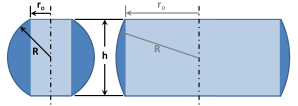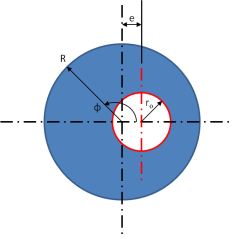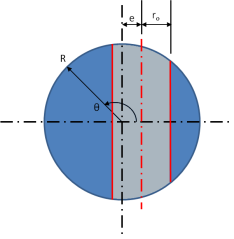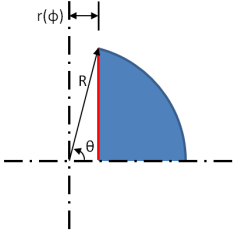A word of warning; if you couldn’t tell already, this is not a home improvement post, in the typical sense. However, it still is a DIY-type post (¿do calculus yourself…?).
A while ago, I wondered, what would the volume of a sphere be if an off-center hole was placed in it? I immediately had confidence that I had the mathematical knowledge needed to solve this problem symbolically (without using a computer). This is easy to do in a 3D modeling software, for a given sphere radius, and given hole radius, but that’s cheating! After an extensive online search, and multiple failed attempts at integration, I finally approached a math PhD, who told me, “unfortunately, this is a real world problem, with likely no solution”. This was discouraging, but I was determined! I focused back on searching library journals until I found the complicated answer in a 1990 journal article. This made me feel better that the answer hadn’t been solved until relatively recently. I have put together this post with information that I have found along the way, so that, if the other two people with hole-in-sphere OCD like me, can rest easy.
In a mathematical sense, a sphere is a 3D surface of revolution of constant radius, where as, a ball is a sphere and the volume contained inside. Distinguishing between the sphere and ball can be important in the annals of Harvard and MIT, but not here. I will use the term sphere throughout this post as reference to a solid ball since it is more relate-able to most people…and to prevent (my own) adolescent jokes.
First, any straight line that intersects the surface of a sphere will always be parallel to the axis of the sphere. A sphere has a definite center-point and the sphere’s axes can freely rotate around that point to become parallel to the line, and the line will then be some distance from the center point (marked eccentricity below).

Putting a hole in a sphere, when the eccentricity is zero (the hole is centered) is easy to calculate. An interesting property of a centered hole in a sphere is that the volume of any sphere can be calculated if you know the height, h, of the hole (this is also known as the “Napkin Ring Problem”). Derivations of this can be found both at Mathworld and SFU.

For the above image, both volumes of the remaining spheres would be:
![]()
Remember, the volume of a complete sphere is:
![]()
In my opinion, the similar form is pretty remarkable. In terms of the Sphere radius, R, and hole radius, r, the volume can be displayed as:
![]() where
where ![]()
Adding a hole eccentricity greatly complicates the volume integral that is used to obtain the above result. My first attempt to set-up and evaluate the equation is shown below, where I used a Spherical Coordinate system, a “pizza-slice” method, and an assumption that the eccentricity is less than the radius of the hole.



In this approach, the bore wall location is a function of the rotation, φ.
![]()
And, the integral can be written as:

The arc-cosine and the sine squared term ultimately prevent the integral from being evaluated.
The solution was finally found in a journal paper written by Francois LaMarche and Claude Leroy. The key to solving this problem is through the use of elliptical integrals. The solution has standard elliptical integrals of the first, second, and third kinds, which can only be evaluated numerically (using a computer). But, it is a solution in a symbolic form (hooray!)
V(R,r,e) [remaining Sphere volume] = 
The following terms are defined as:
Elliptical Integral of the First Kind:
![]()
Elliptical Integral of the Second Kind:
![]()
Elliptical Integral of the Third Kind:
![]()
And the other calculable terms:
![]()
![]()
θ = Heavyside Step Function
There are two special cases where the above equations simplify and the elliptical integrals disappear.
Special Case 1: The hole is centered (e=0).

This is the same result as the integral performed at the beginning of this post.
Special Case 2: R=e+r
When R=e+r, the elliptical integrals disappear. When this case is true, the hole will always be tangent to the equator of the sphere, as in the picture below.

The volume can be represented in a number of ways, one of which is displayed below.
![]()
Viviani’s curve parameters, the 3D line or edge created on the surface of the sphere with the intersection of the cylinder, falls in this special case, however, it is defined precisely when R=2e=2r. The volume can then be further simplified to:
![]()
My OCD (obsessive curiosity disorder) certainly got the best of me on this problem. A lot of time has been spent solving this question, as it is not commonly sought.
References:
Weisstein, Eric W. “Spherical Ring.” From MathWorld–A Wolfram Web Resource. http://mathworld.wolfram.com/SphericalRing.html
DeBenedictis, Andrew. Volume of a sphere with a hole drilled through its centre. www.sfu.ca/~adebened/funstuff/sphere_cyl.pdf
LaMarche, F. & C. Leroy. Evaluation of the Volume of Intersection of a Sphere with a Cylinder by Elliptic Integrals. Computer Physics Communications. 59 (1990) 359-369.